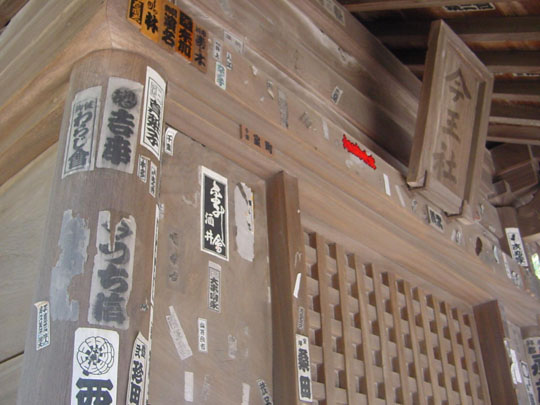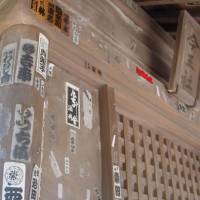Dear Alice,
There's a shrine near where I live that has stickers splattered all over it. The effect is pretty wild and free-spirited, as if a bunch of ravers were let loose on it, and it seems totally out of character for what is otherwise a solemn and super-traditional sort of place. The kanji on the stickers look like names. So, what the heck is up with these stickers? And how do the sticker-uppers get them stuck up in such high places.
Katherine H., Tokyo
Dear Katherine,
You are right about the kanji being names. Those papers are senjafuda, which literally means "thousand-shrine tags," and are posted by visitors to the shrine to mark their visit. The practice is said to date back 10 centuries to the Emperor Kazan (968-1008), who commemorated a pilgrimage to a temple by writing a poem and posting it on the temple gate.
In those days, only the privileged classes were able to embark on religious pilgrimages, and they tried to visit as many famous religious spots as possible. That's the origin of the "thousand shrines" reference. Later, when travel opened up to other classes during the Edo Period (1603 to 1868), commoners embraced senjafuda and refashioned them into a chic pursuit.
There are two distinct types of senjafuda: the black-and-white kind with names that you see on shrines and temples, which are called daimei nosatsu, and the far more colorful and elaborate kokan nosatsu, which were traded with other enthusiasts at events organized especially for that purpose. The only place to see these now is in museums or private collections. The best are true works of art, created by now-famous names in ukiyo-e prints, including Hiroshige, Eisen and Kuniyoshi.
To see the tremendous range in senjafuda design, try to get your hands on one of the beautiful art books edited by Senrei Sekioka, a woodblock printer and senjafuda collector who is recognized as the foremost expert on the subject. I'd suggest starting at your local library because his books are out-of-print and command high prices. The cheapest I found with used-book sellers was ¥10,000; the most expensive was 10 times that amount! A more affordable option is the pocket-size book I picked up new for ¥1,200: "Senjafuda," published by Seigeisha in 2004. The pictures are small but in full-color, and it introduces some 400 different designs from a different collection.
I hadn't realized it until I got your question, but I've never seen anyone actually applying a senjafuda. So I decided to track down Sekioka and see if he'd tell me how it's done. I did find him, but he is now quite elderly and unable to give interviews. Fortunately his son Yusuke, who followed his father into traditional print making, was willing to give me an explanation.
"You can't just march into a shrine or temple and stick your senjafuda wherever you like," Yusuke told me. "You need to go through the proper prayer ritual first and ask at the office if senjafuda are allowed. If you can get permission, you pay a few hundred yen and get their stamp in your nokyocho (pilgrimage book). At that point, you can go ahead and scout out a good location."
The basic rules are that you should never put a senjafuda on an important cultural property or on the framed devotional plaques hanging in some temples and shrines. Another no-no is covering someone else's senjafuda with your own. Beyond that, there are different schools of thought on what constitutes a good location. Some enthusiasts want a spot where their senjafuda will be noticed, while others prefer out-of-the-way places that are sheltered from sunlight and weather. But both schools seem to agree on one point: The higher the better.
Reaching those heights requires a special tool. Yusuke brought out his father's handcrafted bamboo sao (pole), which looks like a sturdy walking stick. But it opens to reveal additional sections that can be telescoped out to nearly five meters in length. "The sao allows you to reach spots about seven meters overhead, factoring in your own height," he explained. "You start by sweeping away dust with a brush fitted onto the end, to prepare the surface. Then you pull the rod down, apply a special glue to the back of your senjafuda, and fix it into a double-hinged clamp on the back of the brush," Yusuke explained. "It requires a lot of experience to maneuver the wet senjafuda onto the wood, release the clamp, and smooth the paper out with the brush."
It's getting difficult to accumulate that practice, however, because an increasing number of shrines and temples now ban senjafuda. Too many visitors were putting theirs up in inappropriate places. Or sticking without praying or paying. Another problem has been the inexpensive senjafuda-like stickers you can make at game centers or online for as little as ¥1,000. They are backed with synthetic adhesives that damage the wood.
It is still possible to acquire senjafuda made in the traditional fashion. To do this, you engage the services of a team of three skilled artisans: a shoka (calligrapher) to do the lettering, a horishi (carver) to cut the letters into a wood block, and a surushi (printer) to apply the ink and make the prints. Prices start at about ¥25,000.
Having a foreign name isn't an obstacle — you can use kanji that approximate the sound of your name. And in the playful spirit of senjafuda, it's great if the meaning of those characters communicates something about you. My friend Ruth ordered a set with the characters for "rusu," which sounds pretty close to her name and means "away from home." Ruth, however, has her own translation. "I prefer 'out to lunch!' " she told me gleefully. "Just like me!"
A sad update: On November 13, 2010, after this column was written, Senrei Sekioka passed away at the age of 86. His work in creating beautiful senjafuda and promoting scholarship in the field will long be remembered and appreciated.


















With your current subscription plan you can comment on stories. However, before writing your first comment, please create a display name in the Profile section of your subscriber account page.